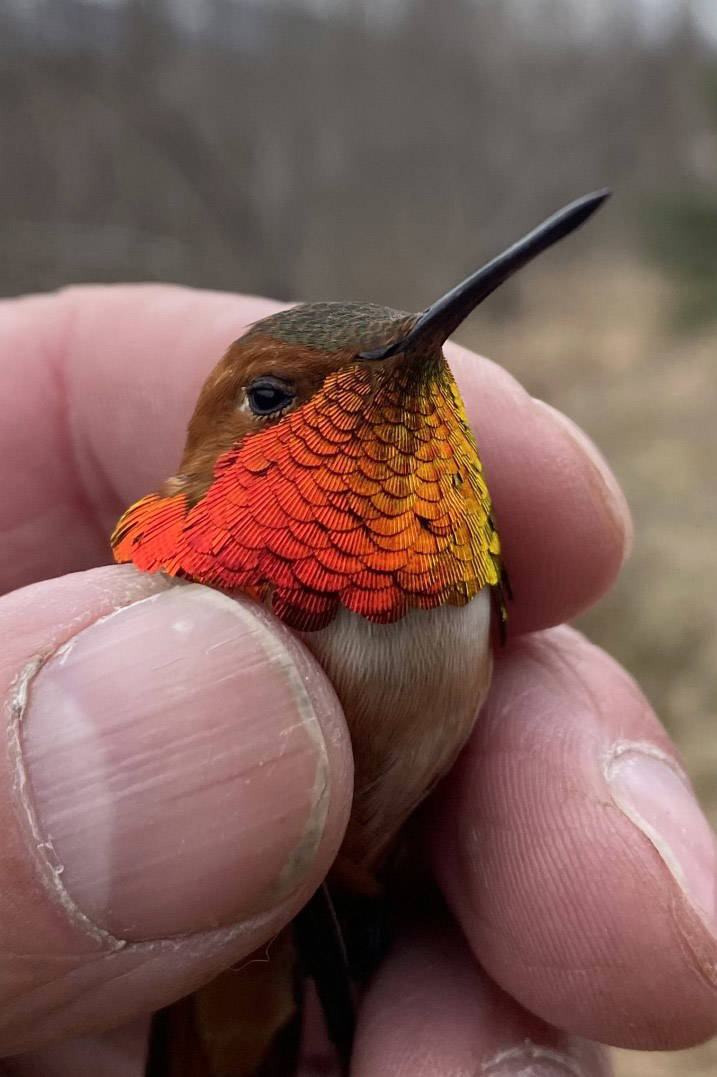Recently, I was in Seward attempting to catch and band the first rufous hummingbird of the year. We had seen the bird the day before, and I was sure it would make a return appearance.
My trap was set perfectly, and the weather was ideal. The afternoon sun was just gracing the trap and feeder, which glowed like a red beacon. Then I heard the unmistakable buzz of a male rufous hummingbird. It is a combination of buzzing wings and a high-pitched whistle created by their very pointed, wingtip feathers.
He approached the trap cautiously like he had seen this setup before. He just hovered there for 15 seconds studying the trap and looking at the feeder.
I held my breath as he let his guard down and entered the trap. He settled and began sipping from the feeder.
When his head was down, I quickly closed the door behind him. My thoughts turned to whether this was a bird that I banded last year. Maybe it spent the winter in Alabama and was banded down there.
As I approached the trap, he moved to the back, flying up to the top as they all do. I carefully reached my hand inside. Before I could even get so much as a fingernail on him, he shot down my arm and out of the trap. My heart sank as I realized I would never know if he was banded or anything else about him.
I left the traps up for a couple more hours and he came back and flashed me his bright red gorget several times, seemingly to indicate his displeasure with my trap still surrounding his feeder. On one return trip, he buzzed around the trap and then followed my trip line 40 feet back to me, flaring his fiery throat at me from about 3 feet away, then zipped away over the treetops in an instant.
The speed of this tiny bird as it disappeared over the treetops was spectacular. A 2009 paper by Christopher Clark confirmed that a male Anna’s hummingbird in the bottom of its display dive reaches speeds that make it the fastest vertebrate on the planet if you measure proportional to its body length.
In these dives, they had an average velocity of 385 body lengths per second. Then, when they make the turn at the bottom of the dive to generate the chirp sound with their tail feathers, they are pulling nine G’s!
Last year while working at my banding sites in Seward and the Alaska Wildlife Conservation Center, we routinely watched and heard male rufous doing their display dives. Once you hear that sound, you will never forget it.
They are often displaying just a short distance away from the feeder, trying their best to impress the females and let the other males know this spot is taken.
These types of interactions are what draw people to hummingbirds. There is such an interest in seeing them and for some, attracting them to your yard.
It is also one reason we decided to do a public banding event at the Alaska Wildlife Conservation Center in Portage on May 15. While I have shared as much as I can with folks about the banding process and our interest in studying hummingbirds through Zoom and Facebook presentations, it is not the same as hearing that buzzing whistle sound with your own ears.
It is hard not to be impressed by these flying gems when you learn more about their role as pollinators. They are here for the early flowering plants when insect pollinators are still coming out of their winter cycles. Just the simple fact that they may live eight or nine years and, in that time, make annual trips to and from Mexico is awe-inspiring.
Our program, Summer Hummers at AWCC, is an entirely outdoor event, with banding demonstrations, minitalks about rufous hummingbirds, and COVID-safe, self-guided kid’s crafts related to hummingbirds. Banding demonstrations are scheduled for the morning at 10:30 and 11:30.
In the afternoon, we will be hosting several minitalks. Kate McLaughlin of the Alaska Hummingbird Project, Inc., and I will present. Coming to these brief talks you can expect to hear what we know about migration, how hummers get and use their colors, and the diet and feeding of hummers in Southcentral Alaska.
If this sounds like a good outing, join us at the Alaska Wildlife Conservation Center between 10 a.m. and 4 p.m. on May 15. We will keep our fingers crossed that the birds continue to migrate into the Portage area and the weather cooperates.
I did catch five hummingbirds in Seward last weekend, and two were birds I banded the previous year. Still the one that got away may forever haunt me.
Todd Eskelin is a Wildlife Biologist at Kenai National Wildlife Refuge. Find more Refuge Notebook articles (1999-present) at https://www.fws.gov/Refuge/Kenai/community/Refuge_notebook.html or other info at http://www.facebook.com/kenainationalwildliferefuge.
By TODD ESKELIN
Kenai National Wildlife Refuge

